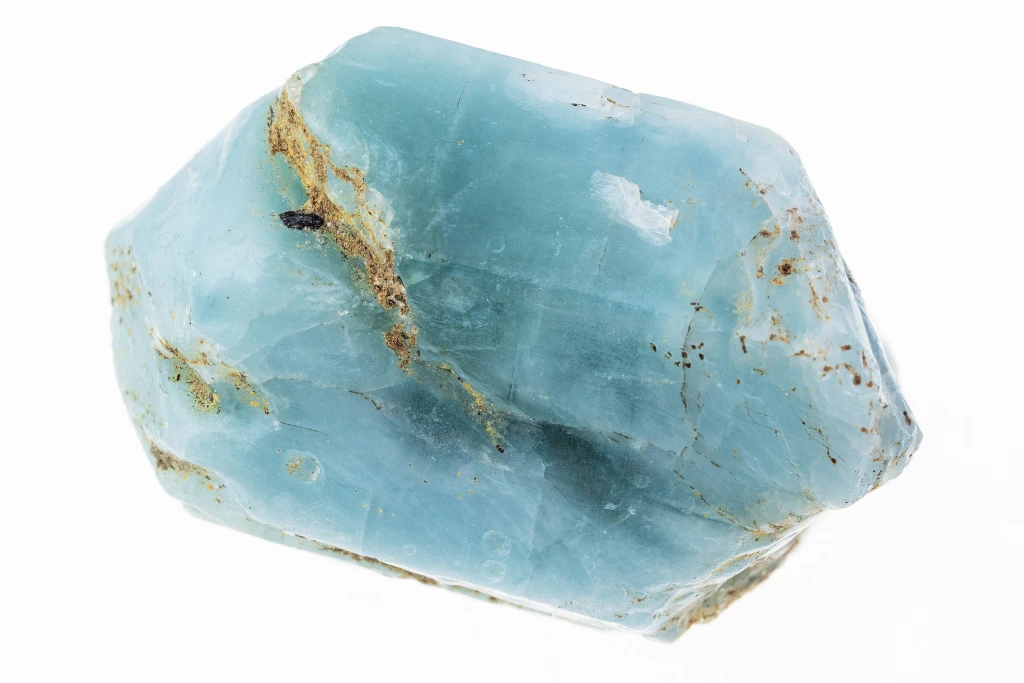Color and Appearance
Blue Apatite is renowned for its striking and vibrant blue hue, which can range from a soft sky blue to a deep, intense teal. The color is often described as reminiscent of tropical waters or a clear summer sky. This captivating blue is one of the crystal’s most distinctive features, making it highly sought after by collectors and jewelry enthusiasts alike.
Crystal Structure
Apatite belongs to the hexagonal crystal system, typically forming six-sided prismatic crystals. These crystals can vary in size, from small, needle-like formations to larger, more substantial specimens. The crystal structure of Blue Apatite contributes to its unique optical properties, including its ability to display chatoyancy or a cat’s eye effect in some specimens.
Texture and Luster
Blue Apatite exhibits a vitreous to subresinous luster, giving it a glass-like shine when polished. The crystal’s surface can range from smooth to slightly rough, depending on its formation conditions. Some specimens may display a subtle translucency, allowing light to pass through the edges of the crystal.
Unique Features
One of the most intriguing aspects of Blue Apatite is its color zoning. Many specimens showcase variations in color intensity within a single crystal, creating a mesmerizing play of light and shadow. Additionally, Blue Apatite may contain inclusions or other minerals, which can create interesting patterns or star-like effects when viewed from certain angles.
Varieties and Associated Minerals
While Blue Apatite is the most popular variety, the mineral can occur in other colors, including green, yellow, and purple. It is often found in association with other minerals such as quartz, feldspar, and muscovite, which can sometimes be seen as inclusions or matrix material surrounding the Blue Apatite crystals.
Historical and Cultural Significance of Blue Apatite
Blue Apatite, though not as widely known as some other gemstones, has garnered attention for its striking blue color and metaphysical properties. Historically, this stone has been confused with other blue gems like aquamarine and tourmaline due to its similar appearance. The name “Apatite” comes from the Greek word “apate,” meaning deception, reflecting its often-mistaken identity.
Metaphysical Associations
In the realm of crystal healing and metaphysics, Blue Apatite is highly regarded for its spiritual and mental benefits. It is believed to enhance mental clarity, stimulate creativity, and improve communication skills. Many practitioners associate this stone with the throat chakra, claiming it can help in self-expression and public speaking. Additionally, Blue Apatite is thought to facilitate spiritual growth and deepen meditation practices.
Common Uses and Benefits
Blue Apatite is commonly used in jewelry and as a decorative stone, prized for its vibrant color and affordability compared to some other blue gemstones. In alternative healing practices, it is often employed in crystal grids, carried as a pocket stone, or placed on the body during meditation. Some believe that Blue Apatite can aid in weight loss efforts by suppressing hunger and promoting a healthy metabolism. It is also thought to encourage personal growth, boost self-confidence, and help in overcoming feelings of lethargy or apathy.
Modern Applications
In recent years, Blue Apatite has gained popularity among those interested in crystal healing and energy work. It is frequently incorporated into holistic wellness routines, used in reiki sessions, and featured in mindfulness practices. Some modern crystal enthusiasts claim that Blue Apatite can help balance emotions, reduce stress, and promote overall well-being. While these benefits are not scientifically proven, many individuals find comfort and inspiration in working with this beautiful blue stone.

